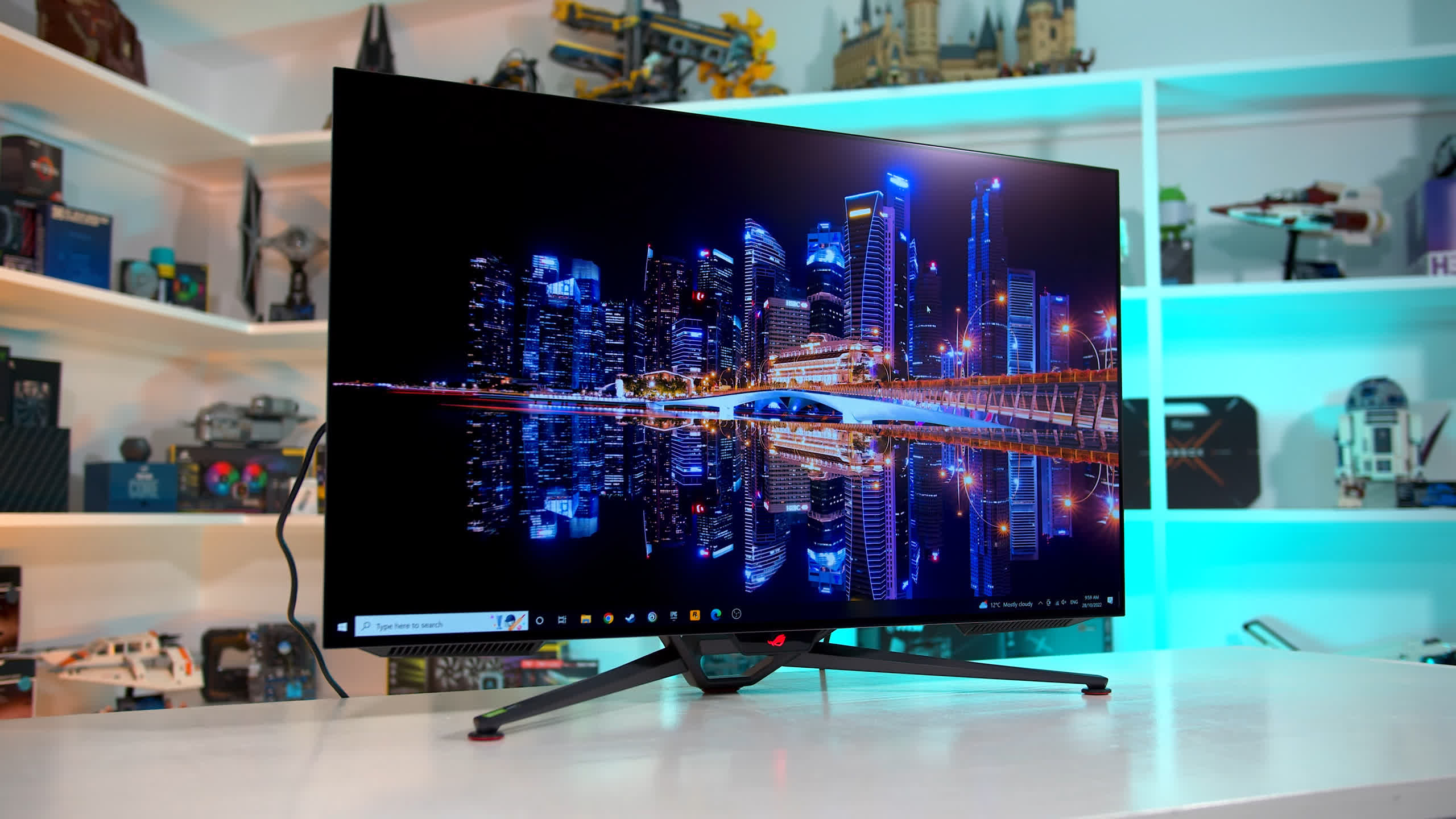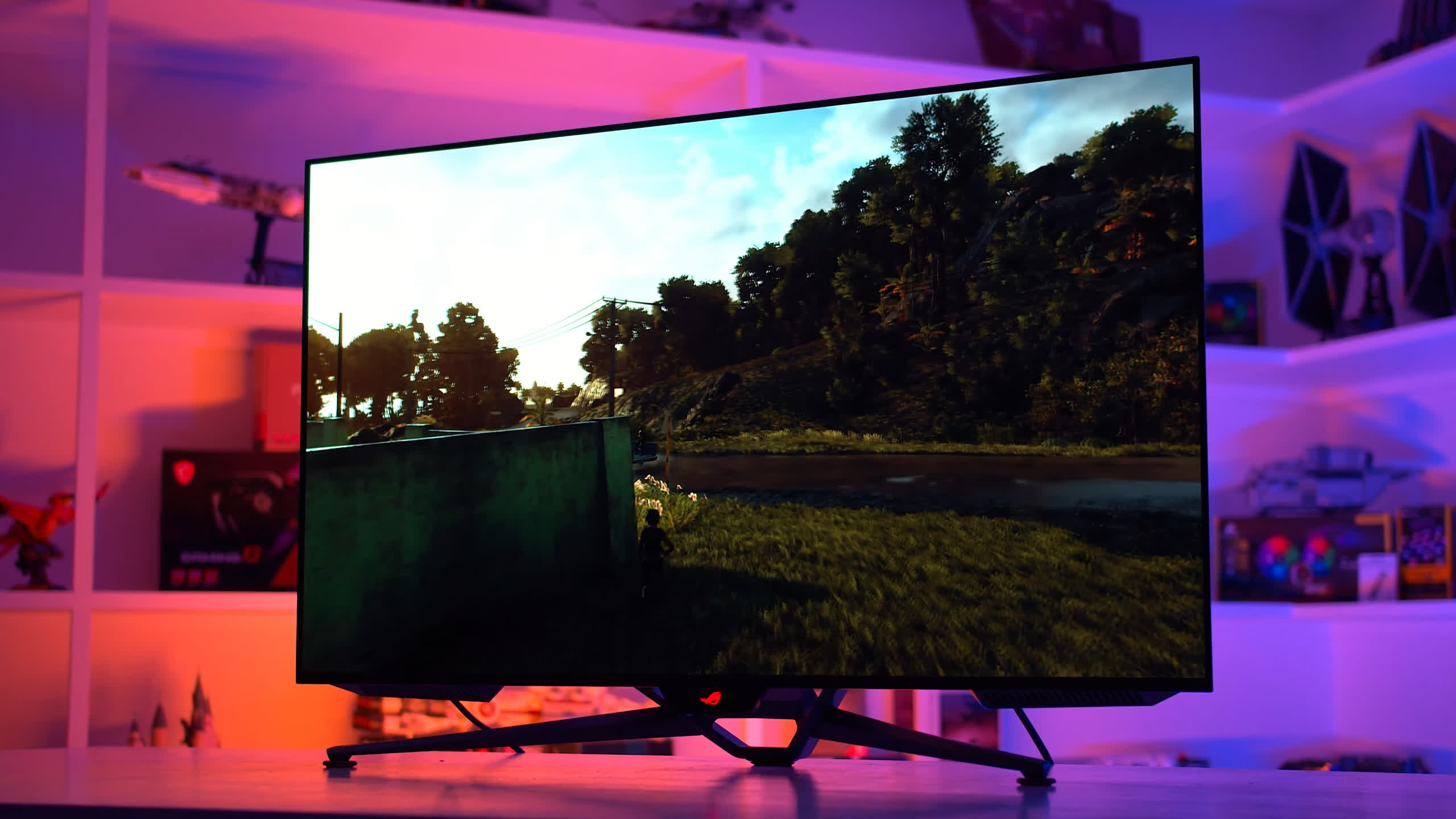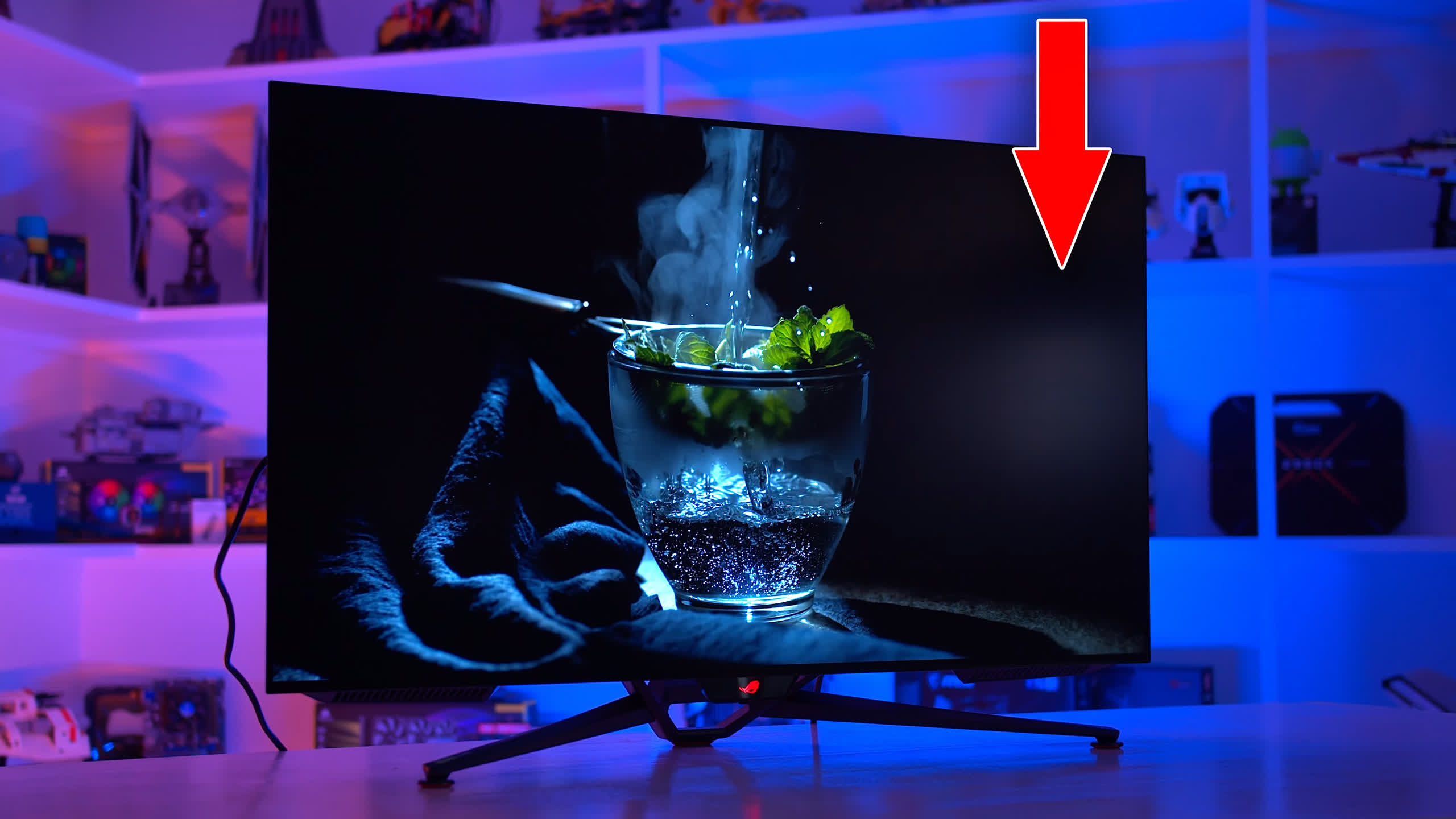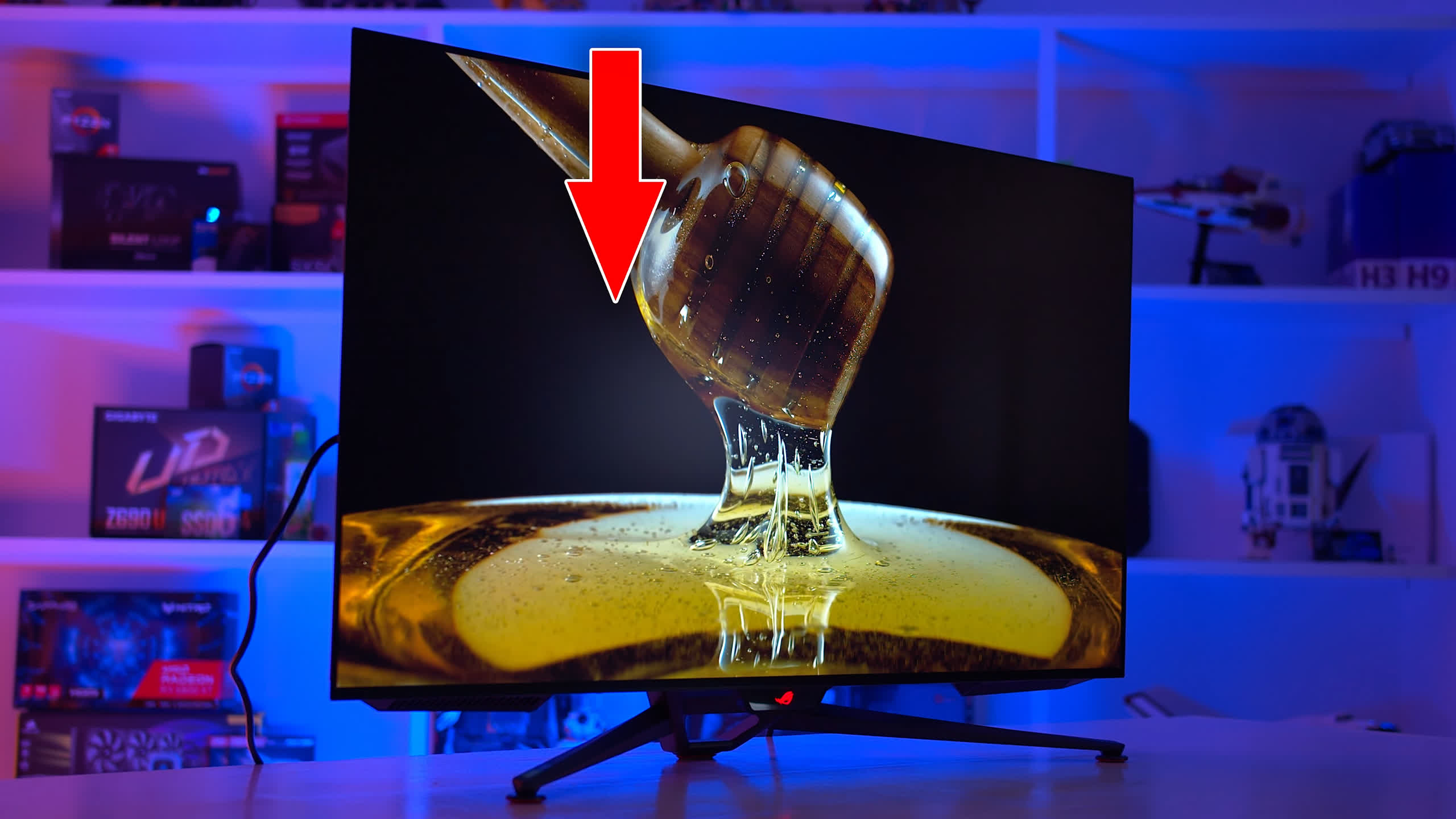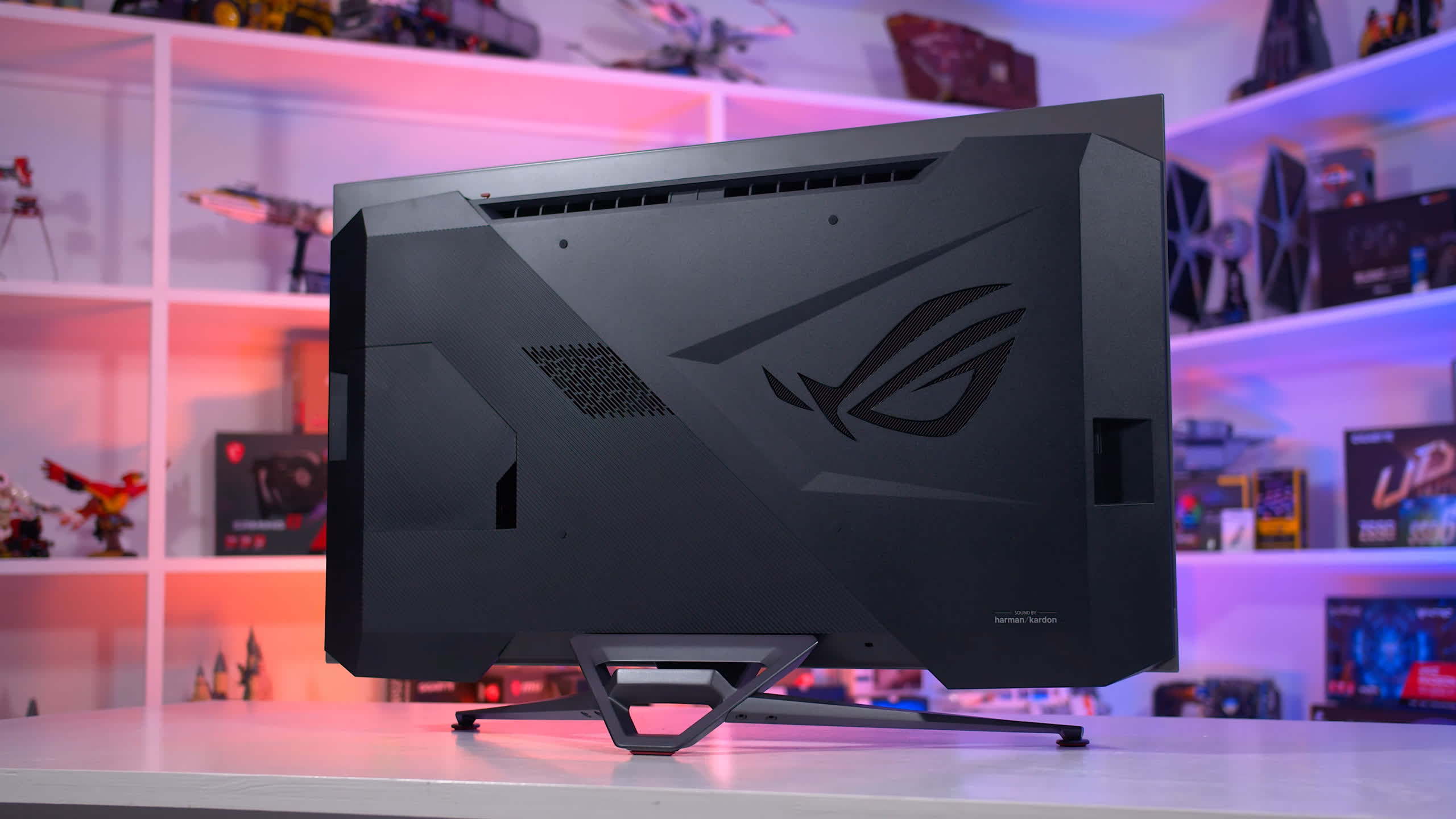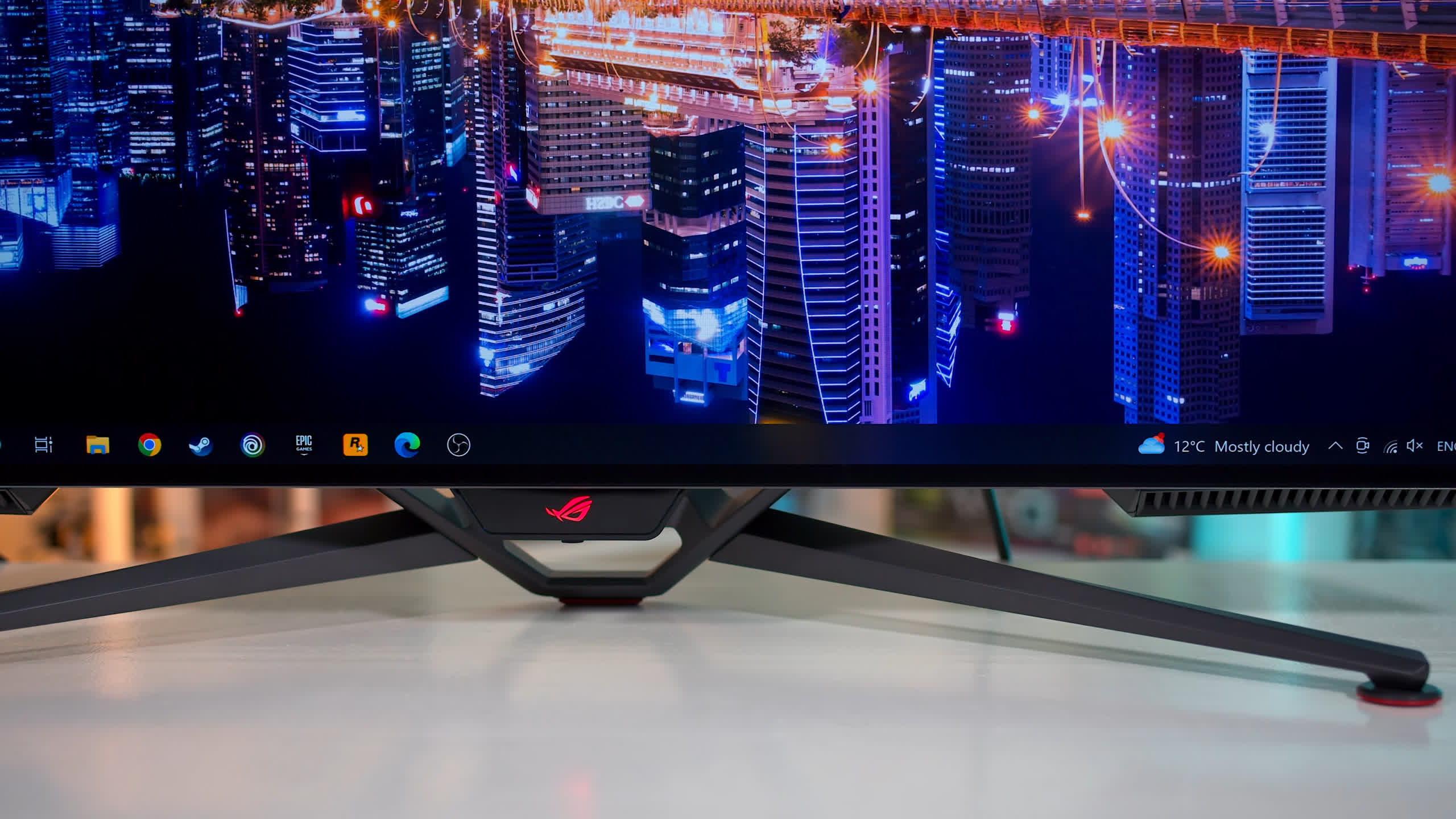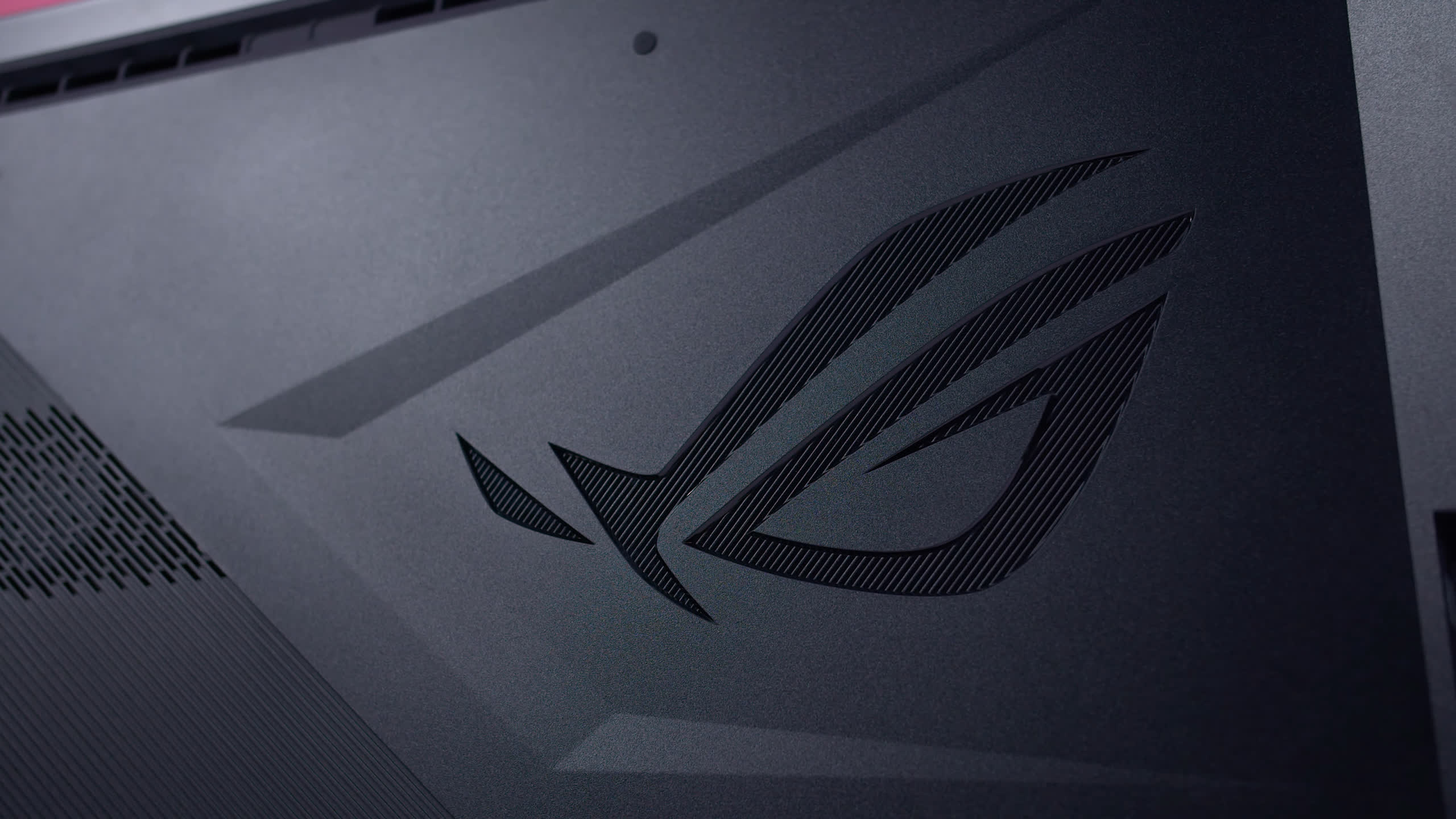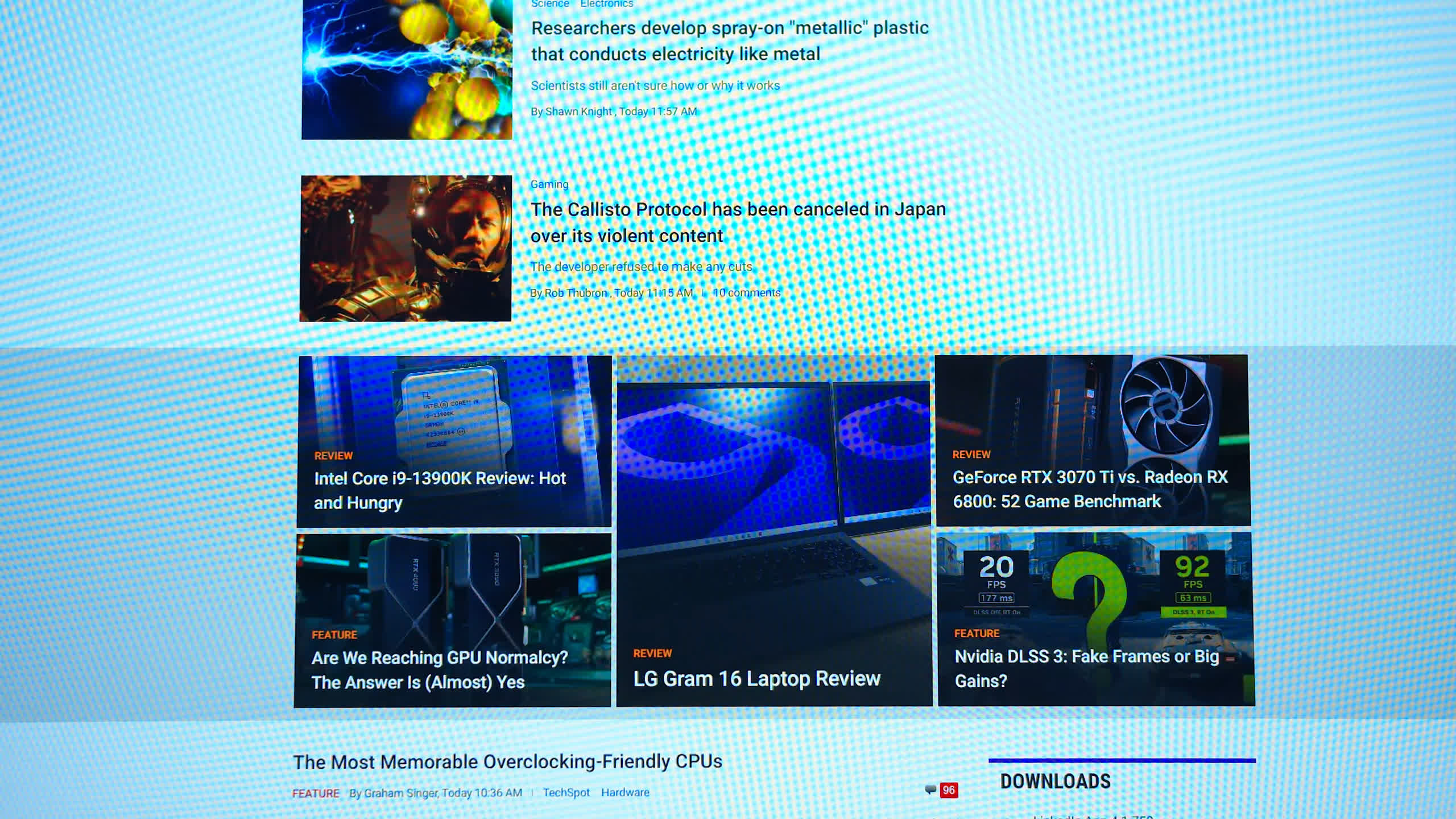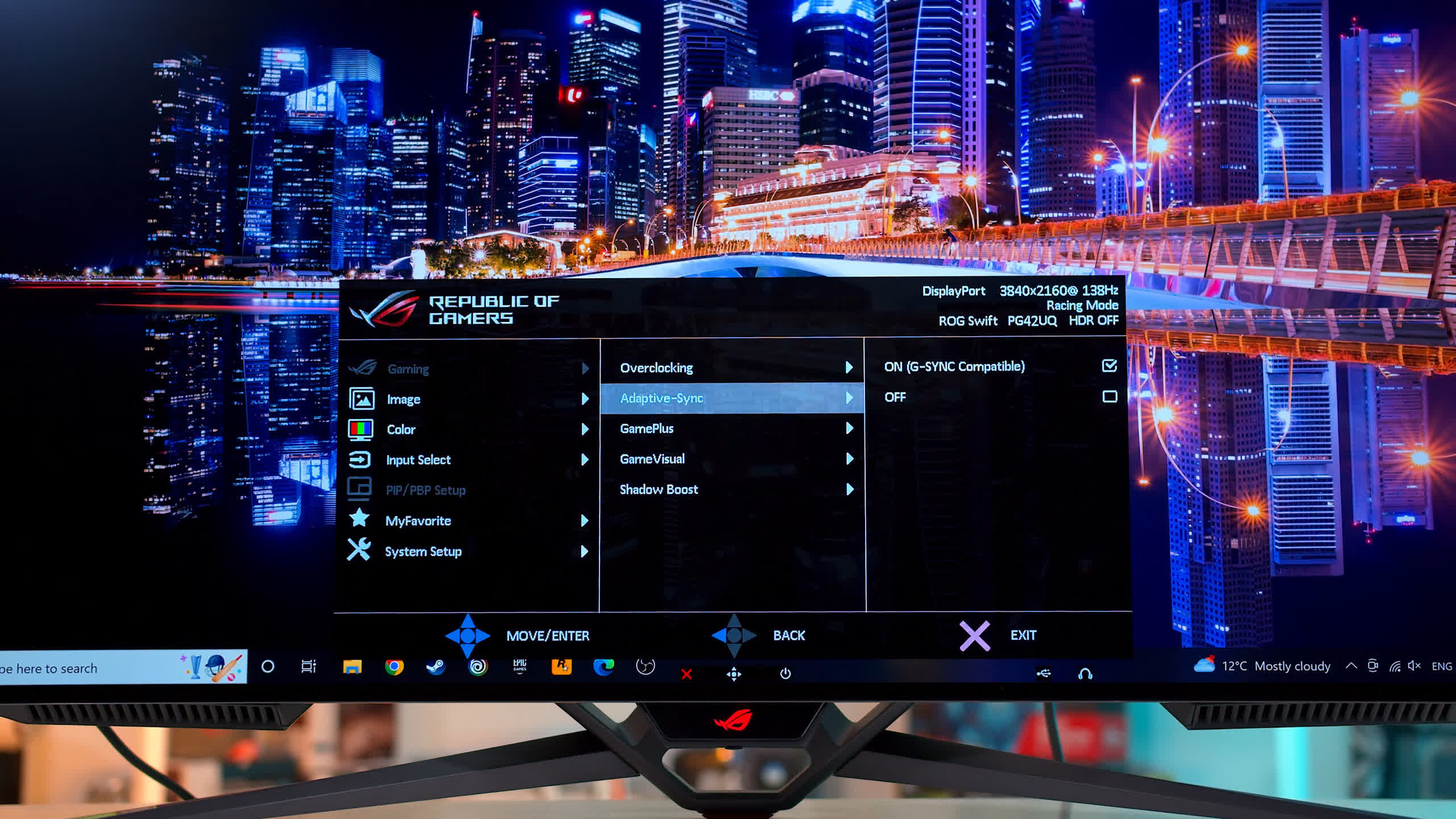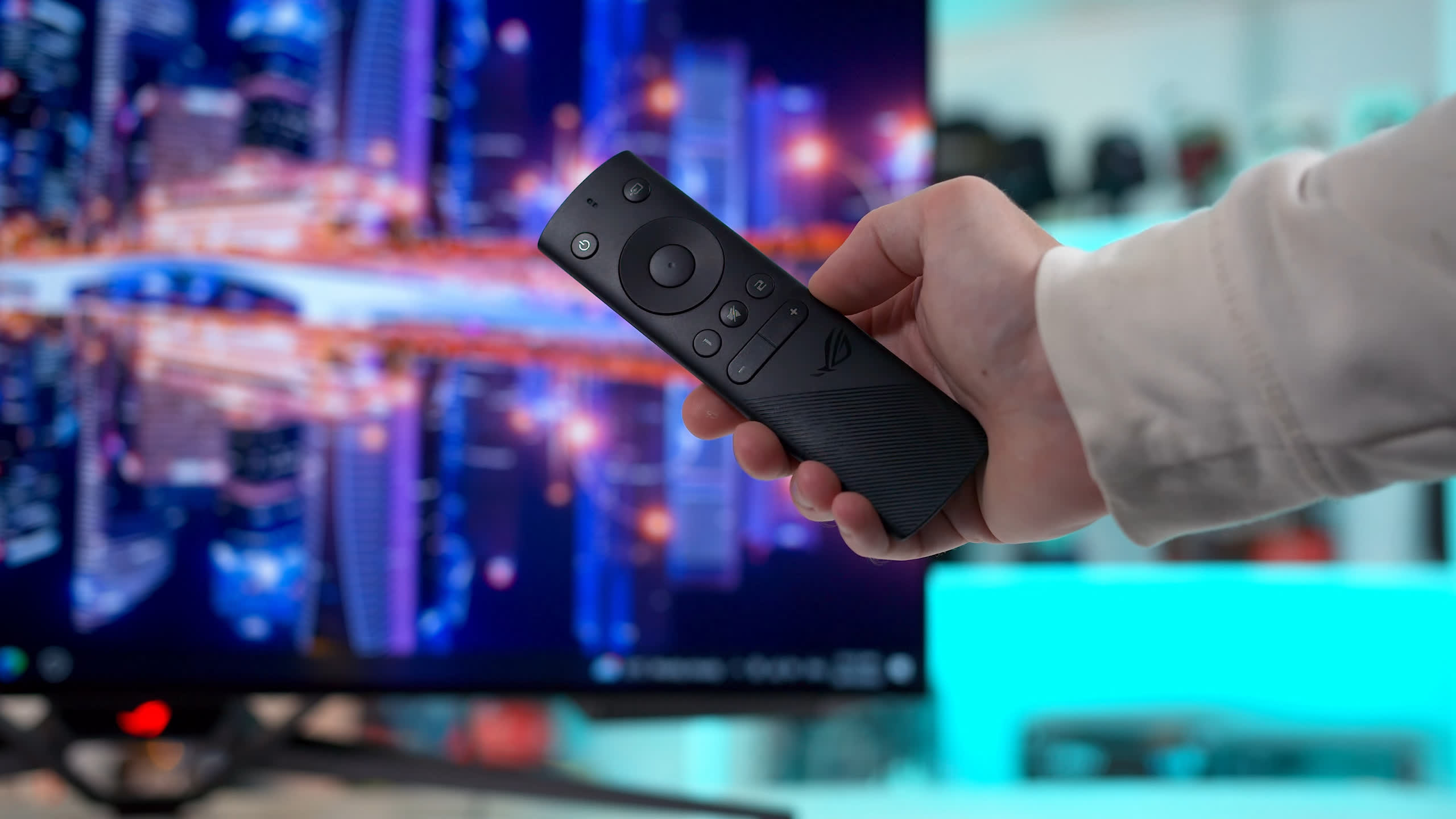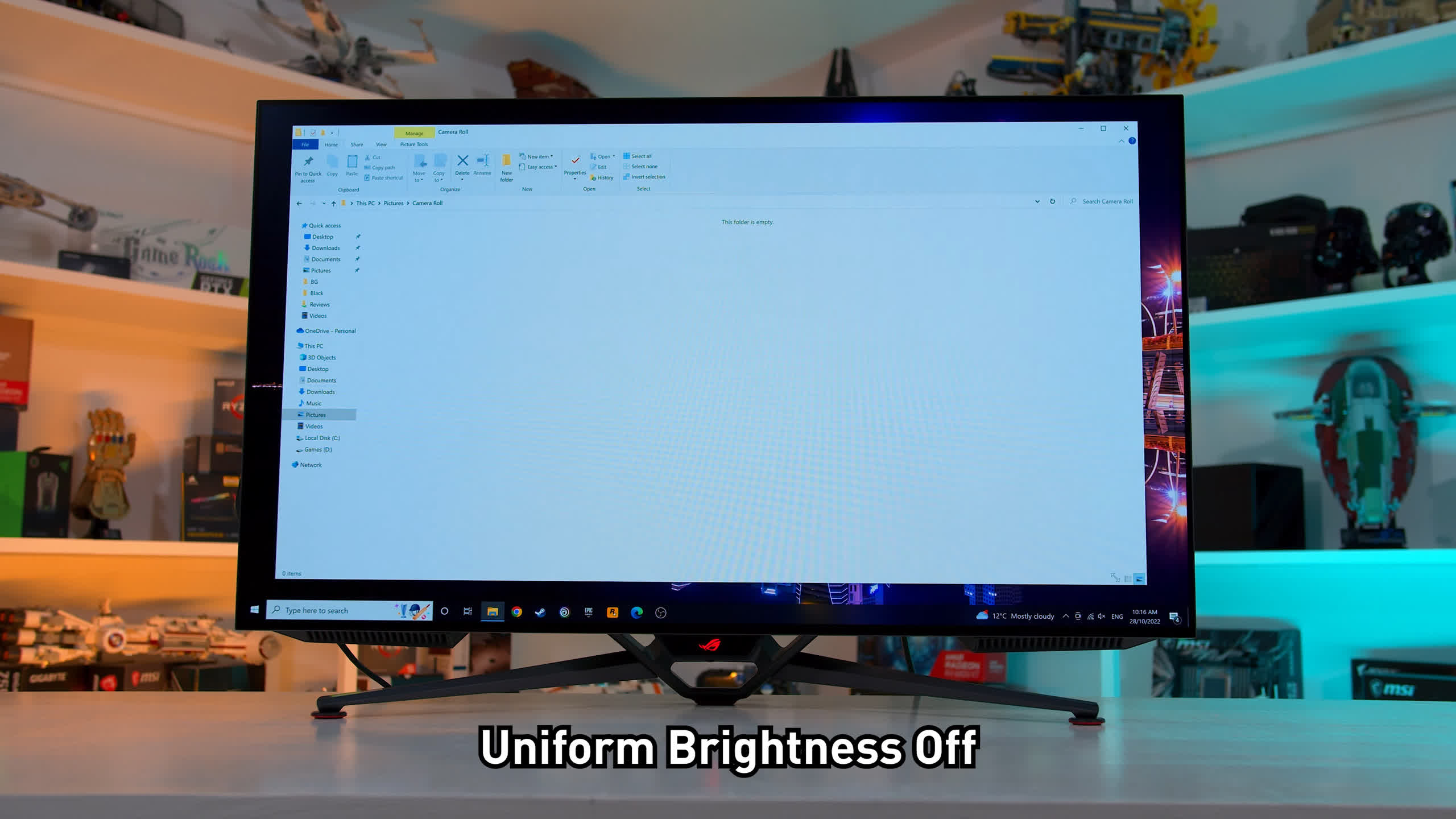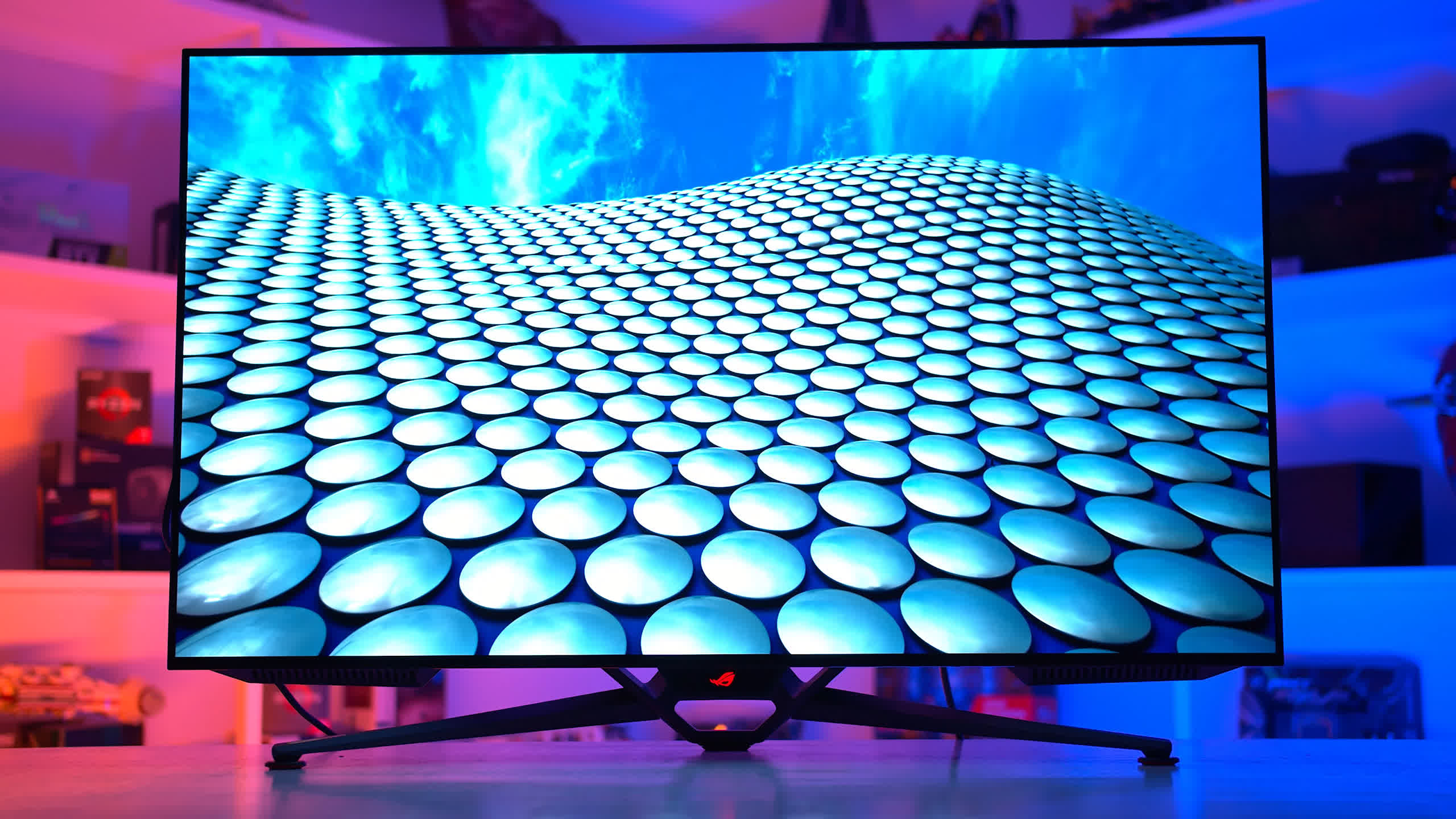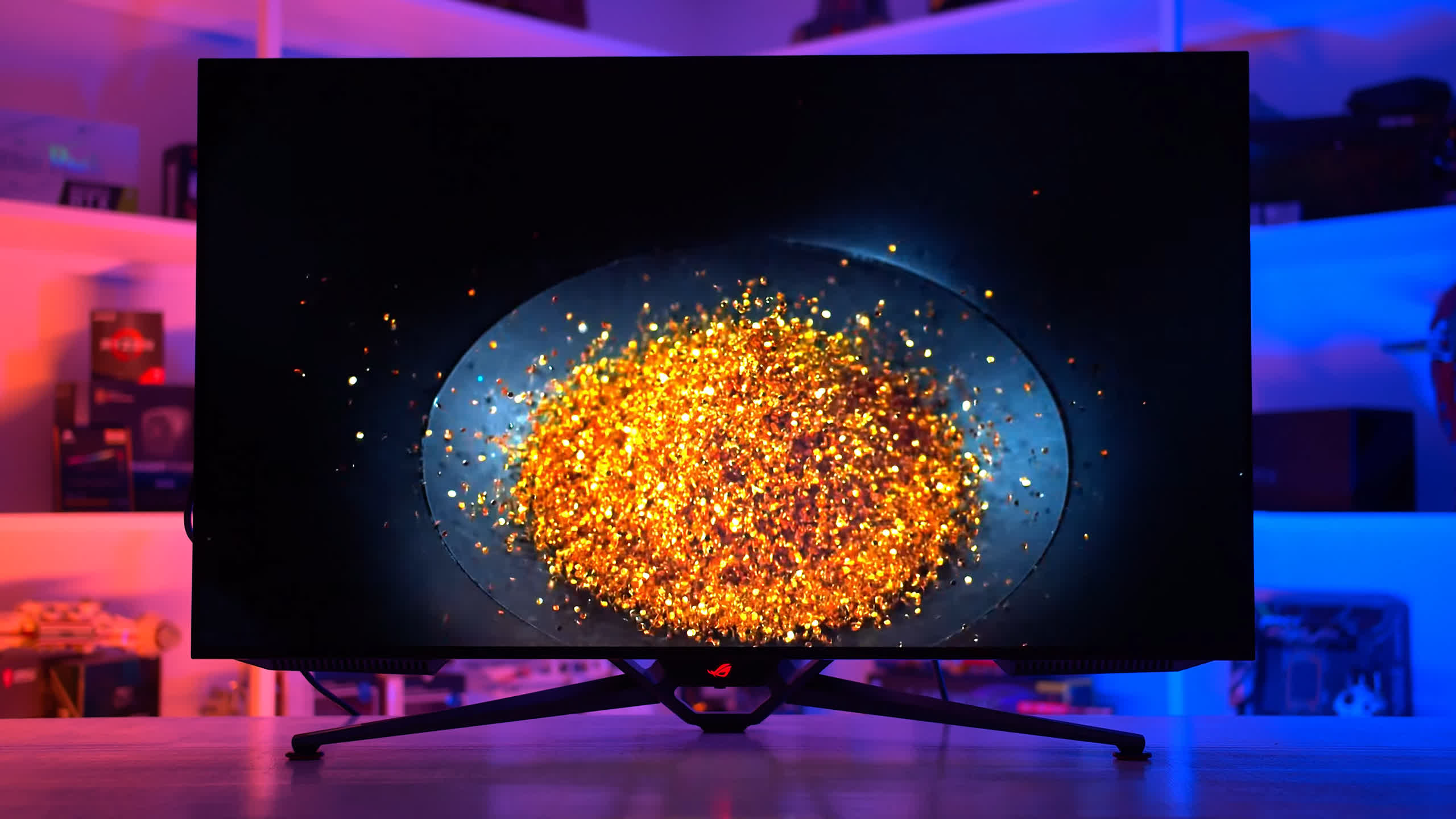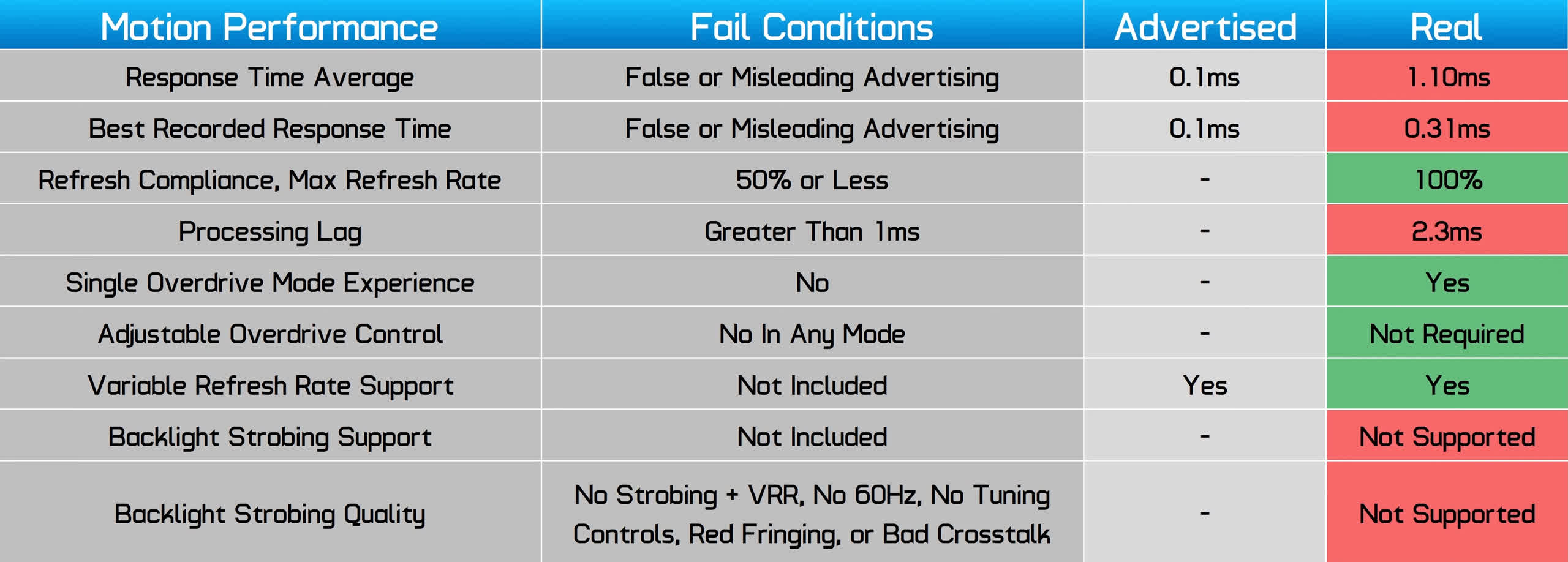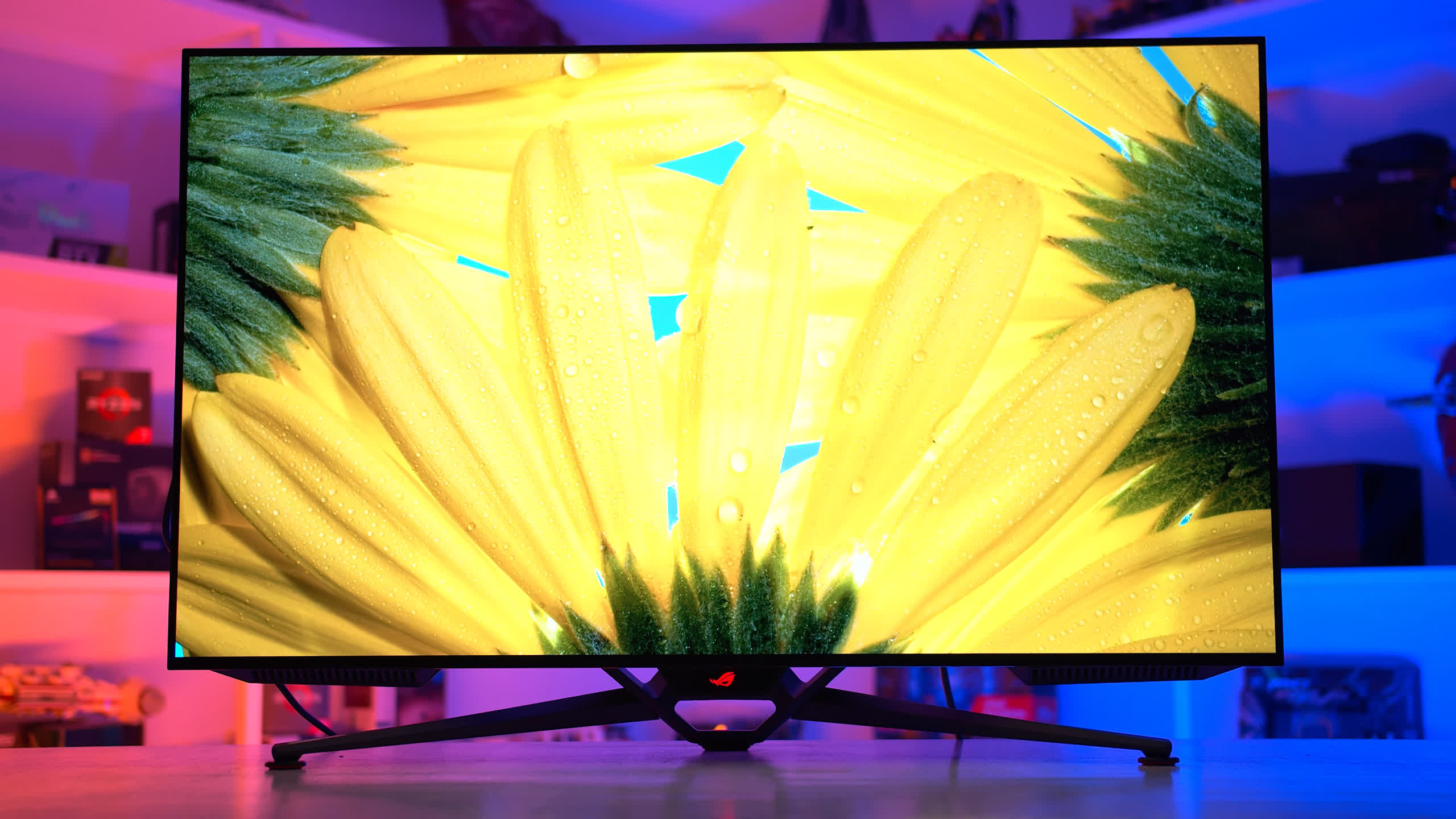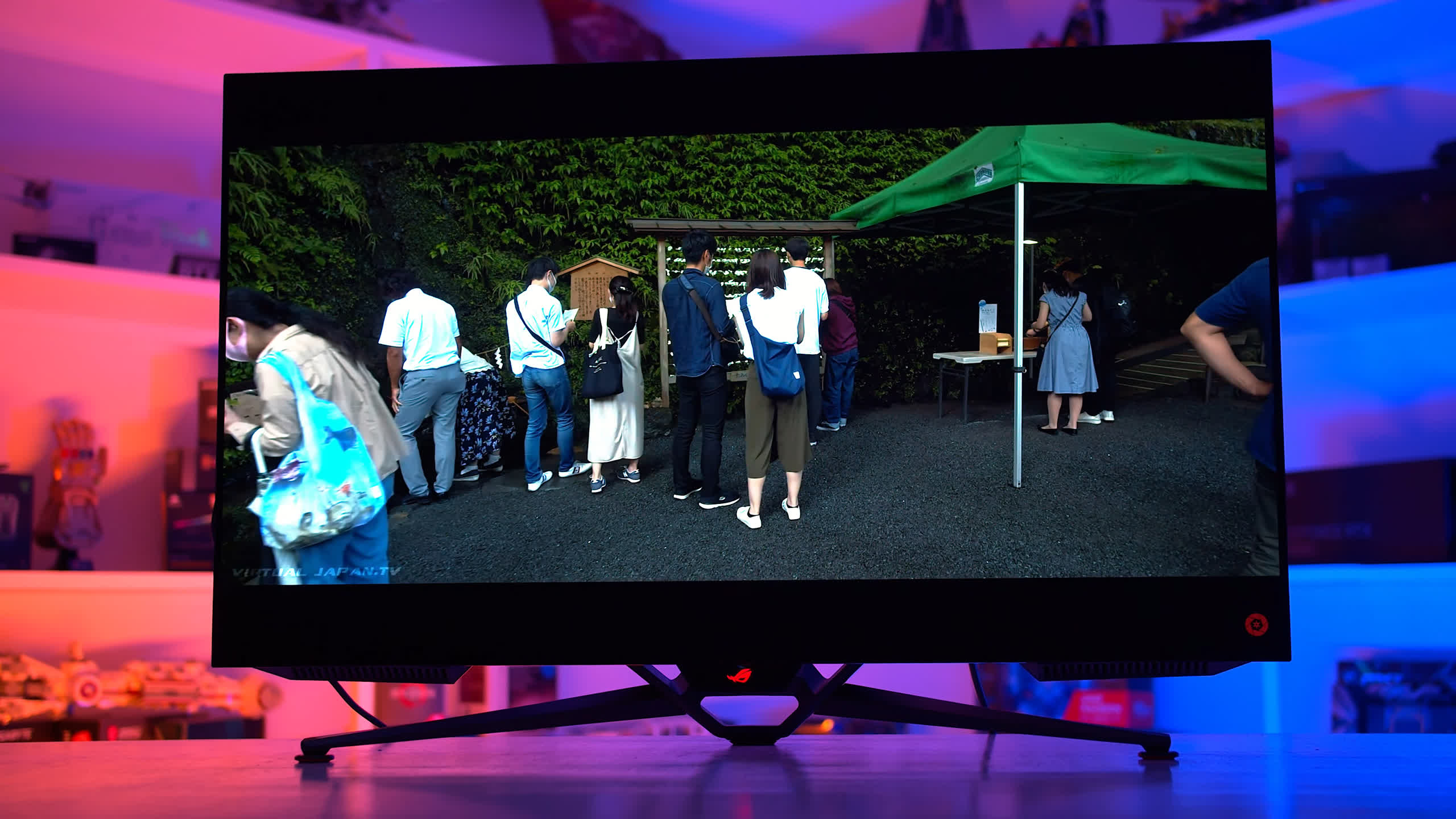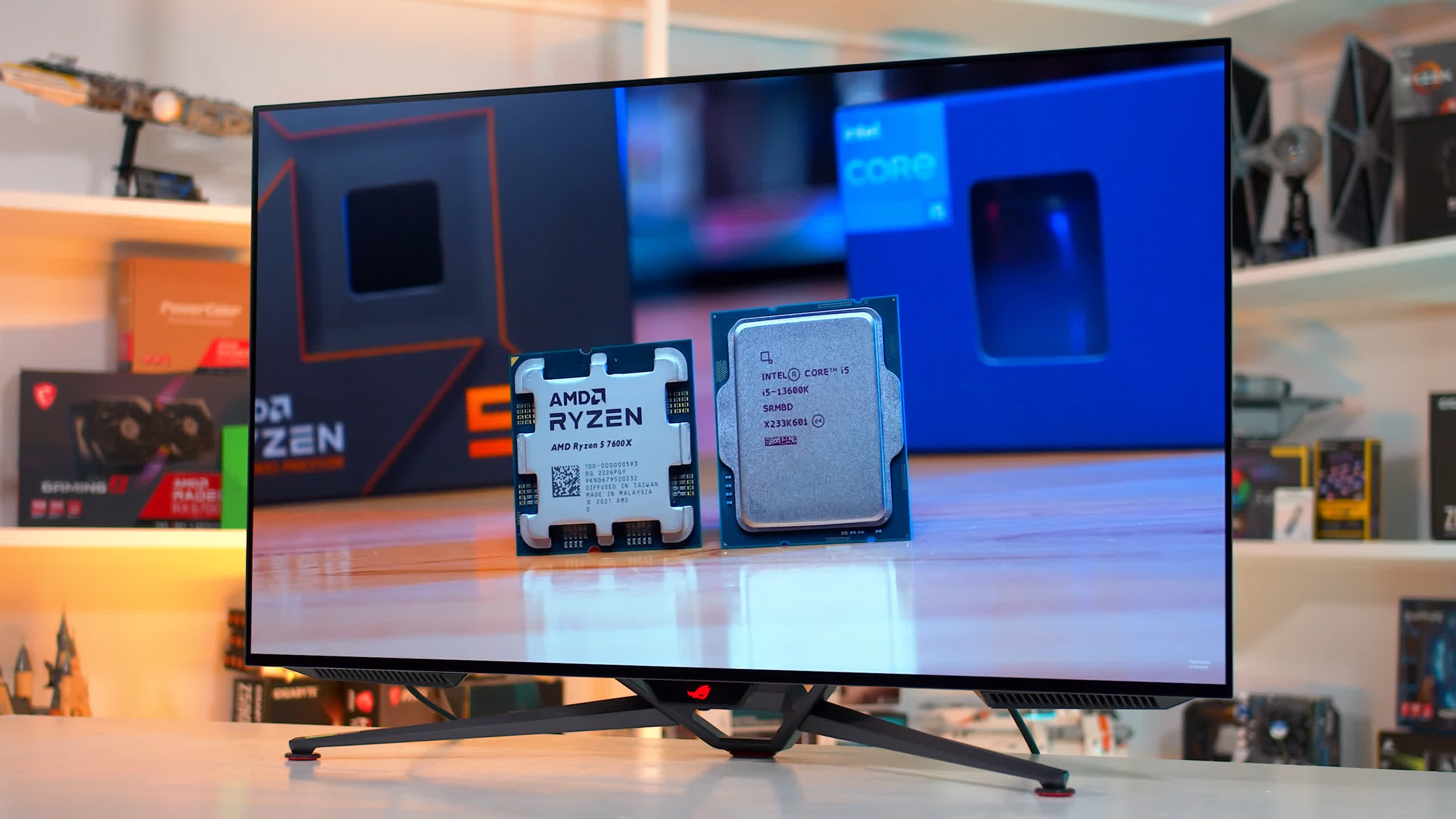The Asus ROG Swift PG42UQ is a 42-inch 4K OLED gaming monitor that’s set to compete and become a better PC gaming alternative to the popular LG C2 OLED TV. With both displays using the same LG OLED panel, it’s going to be interesting to see how they stack up in terms of performance, features and value – and whether it’s worth buying something like this, or maybe a QD-OLED ultrawide like the Alienware AW3423DW.
The basics of the Asus PG42UQ are very similar to the LG C2 in its smallest 42″ size, as both use a 42″ LG WRGB OLED panel. However, the Asus variant pushes up the refresh rate from 120Hz to 138Hz through overclocking, giving buyers a small refresh rate advantage.
It also features DisplayPort connectivity in addition to HDMI 2.1, making it more compatible with a wide variety of PC GPUs – plus it still supports all the usual adaptive sync features we’ve come to expect from a PC monitor.
The Asus ROG PG42UQ will set you back $1,400, which is the same MSRP as the LG C2 42″, however in the last few months the LG C2 has been falling in price and we’ve seen it as low as $1,000. That puts the Asus model at a premium, so we’ll explore how that affects things later.
Aside from the higher refresh rate and inclusion of DisplayPort, the other main difference between the LG and the Asus is the display coating, a point of contention when the differences were first unveiled. Basically, the PG42UQ uses a matte anti-glare finish, while the C2 opts for a glossy anti-reflective coating. Which coating is best for you is going to hinge on your environment – for example how bright it is – as well as your personal preference. I’d strongly recommend seeing both displays in person at a local retailer if you can before purchasing one or the other.
If you can’t do that, here’s the basics. The LG C2’s glossy coating tends to make colors pop and increase the clarity and crispness of the image. It also provides deeper apparent blacks, as diffuse reflections are minimized. This increases the “wow” factor, particularly for shadows and blacks, but it comes at the cost of mirror-like reflections. If you have light sources in front of the display, or just a bright room in general, the C2 will likely produce defined reflections that may be noticeable and hurt the viewing experience. It really depends on your tolerance for noticing or caring about this.
The PG42UQ on the other hand does not produce defined mirror-like reflections at all. This is because the matte anti-glare coating stops the front panel acting like a mirror, so if you’re in a bright room or have light sources in front of the display, you won’t notice clearly defined reflections visible on screen. However this comes at a cost: matte coatings produce diffuse reflections, which can limit how deep and rich blacks appear in some environments.
In dark rooms there’s no difference between the PG42UQ and C2 visually. Both produce excellent deep blacks with the full OLED experience. In dim rooms or optimized setups with no light sources causing reflections, the C2 does look a bit better in my opinion, as that’s where the glossy coating shines. In bright rooms, such as during daylight hours, the PG42UQ’s reflection handling gives it the edge and it helps counter the relatively low brightness output of these OLEDs for desktop or SDR usage.
Design
The Asus PG42UQ is also quite a large display, though I think the 42″ size is manageable on a desk and can be used at normal viewing distances. It’s about 12cm wider than the AW3423DW and obviously a lot taller as well, providing 72% more screen real estate than a 32″ display. This is a massive and very immersive monitor, but it’s not as crazy as the 48″ OLEDs we had before and I think this 42″ size is about as large as we’d want to go on a desk.
As for the design, the PG42UQ does have a superior stand to the C2 in that it supports tilt adjustment but otherwise the Asus model is much more ‘gamery’ in its overall appearance. The LG C2 is a really sleek product with a basic rear panel, while Asus has gone with angled elements, visible vents, an RGB LED logo on the front and a bit of gamer styling for the stand and rear. I personally prefer the way the C2 looks and think it will fit in better with more setups, but I’m sure others will prefer the PG42UQ. Either way, you don’t get much ergonomic control as neither have any height adjustability.
The PG42UQ includes one DisplayPort, two full bandwidth HDMI 2.1 ports, two HDMI 2.0 ports and a smattering of USB ports. There’s also reasonably okay built-in speakers. The port selection is great for PC gamers thanks to the inclusion of DisplayPort 1.4 with DSC, and you can also easily hook up consoles through HDMI 2.1. However, if you have a lot of HDMI 2.1 high refresh rate inputs to use, the LG C2’s four HDMI 2.1 ports might be more suitable, though I think having two plus DisplayPort will be sufficient for most people.
For text clarity, the PG42UQ isn’t a great monitor to use for desktop work due to the RWGB subpixel layout. This means that in addition to the normal red, green and blue subpixels for each pixel, LG, who manufactures this OLED panel, also includes a white subpixel to improve brightness and other aspects to display quality.
However, in the modern world of subpixel text rendering, any time the pixel structure differs from RGB, text clarity tends to suffer to some degree. I still found the PG42UQ to produce generally clear text, but it was inferior to the IPS monitors I use daily, though the Windows ClearType utility can help fix this to some degree. RWGB is not as bad as BGR for clarity and I think it’s also better than the triangle RGB structure used on QD-OLED monitors, but it’s something to keep in mind.
The Asus on-screen-display is okay, including all the basics for a monitor, it’s very similar to previous Asus displays. This means you get some gaming features including FPS displays and crosshairs, a bit of a surprise as these sorts of static elements can cause burn-in on OLEDs, so I’d avoid using them. However Asus do implement several screen protection features including screen moving, logo detection and a screensaver that dims the image, all of which can be enabled or disabled.
While this is a decent feature set, it pales in comparison to the LG C2 which is a full smart TV with a tuner, app store, and many more functions including AI-based upscaling and other additions. LG also provides a much more comprehensive suite of color calibration controls. With that said, both options come with a remote for accessing the OSD, so you don’t always have to use the directional toggle that’s also available.
Also, on the software, I tested this monitor with the V031 firmware revision. Some users have reported issues with the newer V032 firmware so I didn’t install it, and I’d recommend you don’t as it may prevent the monitor waking from sleep. Asus are working on a fix that will be available soon.
Display Performance
Response time performance is next up and being an OLED I was expecting excellent results and, well, Asus delivered. As this uses the same panel as the LG C2 OLED, the PG42UQ performs almost identically to the C2, with an average response around 1ms and no overshoot concerns. Cumulative deviation is also excellent with a very low result in line with other OLED displays.
One of the benefits to OLEDs in addition to its elite speed is that this performance is held across all refresh rates without any need for overdrive. Whether we’re talking about the 138Hz maximum refresh or down at 60Hz, the PG42UQ delivers the same speed. The only difference between these refreshes is the smoothness and sample and hold motion blur, the actual response times are the same though.
Compared to other monitors, the Asus PG42UQ offers the same OLED speed we’ve come to expect from other displays using this type of panel. This means that comparing best performance to other display technologies, we’re looking at a minimum of 2.5x faster performance plus lower overshoot. And that’s comparing best OLED to best LCD, for most LCDs there’s more like a 4 to 5 times advantage in favor of OLED.
Due to OLED’s excellent performance across all refresh rates this margin only grows when comparing average performance across the entire refresh rate range. OLEDs are simply on another level to LCDs and this is a key reason to purchase one. It really doesn’t matter which metric we look at, whether that’s cumulative deviation or performance at fixed refresh rates, you’re getting the full OLED experience from the PG42UQ with speed far greater than today’s best LCDs.
The PG42UQ’s input latency is fine. It’s not quite as good as the LG C2 at least under my test conditions, but around 2ms of input latency is superior to the AW3423DW and indeed most LCDs operating using HDR. While this graph is specifically looking at SDR performance, mini-LED monitors such as the Neo G8 do have much higher latency in their HDR mode – though for competitive gaming you’d probably disable HDR.
Unlike the LG C2, the PG42UQ does not support backlight strobing. This is due to limitations imposed by panel manufacturer LG, and even on the C2 it’s not very good as for some reason it only supports strobing at 60Hz. An unfortunate omission, but at least the panel is otherwise quite fast.
Power consumption is high, as we’re stress testing every monitor by using a full white image for this test. The PG42UQ gets close to 200 nits but ultimately can’t manage it, while still consuming 115 watts which is as high as this display gets. Typical power usage during real world content is lower, but still between 45 and 65 watts.
Color Performance
Color Space: Asus ROG Swift PG42UQ – D65-P3
Moving on to color performance, the PG42UQ is a wide gamut monitor with identical capabilities to the LG C2 OLED. It supports 96.4% DCI-P3 coverage in my testing, just 0.2% away from the C2 as we measured it, which equated to 71% Rec. 2020 coverage. The gamut doesn’t really extend much into Adobe RGB, but for content consumption that’s mostly focused on P3 this is a good level of wide gamut support.
Default Color Performance
The PG42UQ has much better factory calibration than the C2. It’s not perfect as the default setting is to not clamp the gamut to sRGB in the SDR mode, however greyscale performance is far better with more accurate white balance and lower deltaEs. The balance of things here gives the PG42UQ similar factory performance to the C2 in ColorChecker, but a big advantage in greyscale that sees it perform more typically of a gaming display.
sRGB Mode Color Performance
The PG42UQ also benefits from having an easy to enable sRGB clamp that doesn’t impact other settings, so you still have full control whether you use the sRGB or P3 modes. This setting is easy to enable and improves performance for SDR content, now it’s not perfect, there’s still a few issues with saturation but the combination of more accurate colors and decent greyscale is very usable.
Calibrated Color Performance
While factory performance is decent, the PG42UQ lacks the huge array of calibration options that are present with the LG C2. It’s possible to hardware calibrate the C2 as it has so many options, but with the PG42UQ you just don’t get that level of customizability as its gamma and white balance controls are more basic.
It also lacks features like Calman for LG support, which allows you to use professional software to hardware calibrate the screen. This means that any calibration must be done through traditional software means, not a deal breaker as performance is still reasonable and the panel is easy to calibrate in this way, it’s just not as elite as what LG offers from their similar display.
Like other OLEDs, the weakest aspect to this type of display is peak brightness. When displaying a full white image, the PG42UQ tops out at 196 nits which is close to the 200 nit minimum we like to see. It also ended up 9% brighter than our C2 unit, a solid result but not game changing.
What is superior with the PG42UQ though is its ‘uniform brightness’ mode. This essentially disables the automatic brightness limiter or ABL, capping the display brightness to this 196 nit level regardless of what content is being shown on screen. The normal configuration can see brightness exceed 300 nits when brightness is set to 100, depending on what content is being shown. But this can be distracting for desktop app usage as the ABL is constantly changing the level of brightness in a noticeable way. With the uniform brightness mode we don’t get as high brightness in some conditions, but it’s more even and usable for desktop use which is a huge plus.
Minimum brightness is good if you want to use the PG42UQ in a dark room without burning your eyes. And of course showing a contrast graph would be a bit pointless as the OLED screen has an effective infinite contrast ratio, obliterating LCD panels in the process as an OLED can deliver far more rich, inky blacks. However what I will show instead is a black level chart, which illustrates how the OLED screen compares to various LCD technologies when the display is calibrated to 200 nits. Nothing else comes close to the OLED’s black levels.
Viewing angles from the PG42UQ are excellent but uniformity was mediocre with my unit, there was a noticeable blueish tint on the left side of the panel which could be seen when the display was showing large areas of white. This was less uniform than my LG C2 unit I purchased at retail, though this could be down to panel variance so it’s hard to say what sort of uniformity you will receive.
Risk of Burn In
Before talking about the HDR experience, it’s worth discussing the permanent burn-in risk associated with OLED displays. This is one of the major drawbacks that prevents the PG42UQ and other OLEDs from being well suited to desktop usage, along with its low brightness. Desktop usage frequently includes viewing static images, whether that’s the taskbar or just general application windows like the navigation bar in Google Chrome. These all present a risk of burn-in, as static content is bad for an OLED.
How long it will take to burn-in the display when using it as a desktop monitor is not something I can answer, as it will take a while to figure that out even with 24/7 usage. But I would expect that with normal PC desktop application usage, the PG42UQ will burn-in faster than if you were just using the display for content consumption like movies or games. I’ve seen several reports from fellow YouTubers like Linus that suggest with long periods of static desktop app usage, LG panel OLEDs can burn-in rather quickly.
Asus does implement some screen protection features as discussed earlier, however I found the screen shift feature annoying as it can cut off vital information from the desktop at times, depending on where the image is shifted to, so that might need to be disabled for desktop usage, further hurting burn-in. I’d also recommend some usage habit changes in Windows, like using a dark mode, enabling screen savers and setting the taskbar to automatically hide.
HDR Performance
The Asus PG42UQ, like the C2 and other OLEDs, is a fantastic HDR display. As an OLED, each individual pixel is self lit, providing the best contrast ratio possible from a modern display technology. Not only does the PG42UQ meet our HDR checklist, but its effective zone count of over 8.2 million dwarfs the best full array locally dimmed LCD monitors that top out at a mediocre 1200 zones in comparison.
In practice this leads to no blooming or haloing when viewing HDR content that has bright and dark areas on screen at the same time. Any pixel that needs to be black, is fully switched off, so even the most punishing HDR scenes like starry nights or small lights on a dark street look perfect and amazing. Even the best HDR LCDs of today like the Samsung Odyssey Neo G7 can struggle with blooming in certain areas despite a high native contrast ratio and lots of dimming zones. OLEDs always look perfect in all conditions, you’ll never have to worry about blooming, and it can be a significant difference at times which leads to excellent image quality in HDR content.
Like when discussing contrast in the SDR section of this review, there’s not much point showing HDR contrast graphs as this OLED is able to achieve infinite contrast, even in checkerboard tests where the Neo G7 tops out around a 20,000:1 contrast ratio. That LCD is definitely very good and gets the closest to an OLED in terms of shadow detail and black levels, but the PG42UQ is a step above again and has the best handling of darker content of any HDR display you can get. Those that care most about black levels should strongly consider an OLED.
The drawback is the same as the SDR section as well: brightness. Full screen sustained brightness is poor and in our testing actually worse than in the SDR mode at just 121 nits. LCD panels crush this OLED in its ability to show a very bright image that takes up the entire screen. The AW3423DW is also noticeably brighter for full screen content, although that QD-OLED isn’t exactly amazing either. In this area there’s no real difference between the Asus and LG variants.
However the PG42UQ is more impressive when showing bright highlights, which is a more typical HDR experience. My PG42UQ topped out at just over 800 nits, better than the 48-inch C1 OLED and quite substantially better than the 42-inch C2, which was a surprise. My PG42UQ unit was 22% brighter in this test than the C2, a noticeable difference that’s further enhanced by how OLEDs can appear brighter due to their extremely high contrast ratio. While this result still falls short of the best LCDs out there, I was satisfied with the level of brightness on offer here.
In terms of how the PG42UQ handles brightness across various window sizes, any scenes with a high APL will be relatively dim, however like we’ve been discussing, the PG42UQ is capable of decent brightness in smaller areas. The average picture level of a lot of film content tends to be below 25% where this Asus model can achieve 400 nits. What’s great about the PG42UQ is that while brightness is similar to the C2 at window sizes below 25%, it flexes its muscles for smaller content and is able to outperform the C2 by nearly 200 nits in some instances. This is a win for OLED buyers that must have the best brightness they can get. Ultimately for me I think this is a good level of brightness for HDR but not the best, though I still feel the overall HDR experience is outstanding when combined with the contrast ratio and dimming ability.
HDR: Grayscale Tracking
For HDR accuracy, the PG42UQ is only okay in my opinion, it’s not a bad result for EOTF tracking but the C2 does a better job of following the correct PQ curve. I’m using the HDR Cinema mode here as it had the best white balance accuracy, though EOTF tracking wasn’t substantially different in the other modes. Accuracy for saturation sweeps wasn’t as good as the C2 either in its HDR mode, but this is a usable result in my opinion.
Essentials Checklist
The final section of this review is the HUB Essentials Checklist, which looks to see whether Asus is accurately advertising the panel and whether it meets minimum performance standards. The first deduction is for not including height adjustment, though this was unlikely to be included on a panel of this size.
In the color performance section, I’ve included three borderline results. Asus advertises 450 nits of typical brightness, though it’s unclear whether this refers to the SDR or HDR modes. 450 nits is easily achievable for HDR content, but less so for SDR. Asus also got very close to meeting color space and factory calibration advertising in a way that I don’t think affects the product and is not misleading, despite falling just short.
However for the response time section, Asus did not accurately report a 0.1ms grey to grey measurement, which wasn’t possible even with our legacy measurements, settling more around 0.3ms best case. I get what Asus are doing here, reporting an order of magnitude faster numbers than an LCD, but it’s not accurate. However HDR performance is great and the only further deductions are related to the subpixel array and burn-in risk. As solid overall showing from Asus here.
What We Learned
Overall the Asus ROG Swift PG42UQ is a great gaming monitor, but whether it’s the best choice for you will likely come down to personal preference, your gaming setup, and of course, pricing. Because this monitor is built using LG’s excellent OLED panels, there weren’t too many surprises in the performance department, and Asus has added a few neat bonuses that enhance this display relative to the LG C2.
Motion performance is excellent on the PG42UQ and the increase to a 138Hz refresh rate is a nifty bonus, providing slightly better clarity relative to 120Hz OLEDs. In addition, we get superb HDR performance, making the PG42UQ an excellent option for HDR gaming.
Blacks are as deep as ever, per pixel local dimming is elite for reducing HDR blooming, and while the brightness capabilities aren’t anything special, the PG42UQ did get brighter than the LG C2 in my testing. Overall color performance is solid, with a good default configuration and decent accuracy.
As this display is built around an LG OLED panel, it also comes with some of the limitations that we’ve discussed before. The PG42UQ isn’t a great monitor for productivity tasks, static content like desktop apps presents a risk of permanent burn-in, and the RWGB subpixel layout isn’t ideal for text clarity. It also doesn’t get very bright relative to LCDs. The Asus PG42UQ is best suited as a pure content consumption monitor, whether that’s watching videos or playing games.
If you’re set on a 42-inch OLED monitor, we’re sure many of you will be tossing up between the PG42UQ and C2. For some people the PG42UQ will have a good set of advantages. The matte coating is better for use in bright rooms and has no impact on black levels in a dark room.
The DisplayPort connector is more versatile, and we appreciate the increased refresh rate. Asus also allows you to easily disable the automatic brightness limiter, which is good for desktop use. The PG42UQ is the brighter of the two options for HDR content, too.
The LG C2 has a different set of strengths. The glossy coating is excellent for dim viewing conditions, OLED blacks look great in those environments. LG has also integrated a stronger feature set, including full smart TV capabilities, a wider range of hardware calibration controls, and support for Dolby Vision, which the PG42UQ doesn’t have. It doesn’t perform as well in areas like brightness, but the calibration features are really appealing.
The biggest difference may be in pricing though, depending on your region. While the MSRP for both displays is similar, the LG C2 is often on sale and we’ve seen it as low as $1,000. It’s hard to justify spending an additional $400 on the Asus ROG PG42UQ in those circumstances. In other markets however they are priced essentially the same, in which case you’ll need to decide what features matter most to you. We can’t say there’s a clear answer or winner between these two as they both offer something a bit different while sharing most of its strengths.


